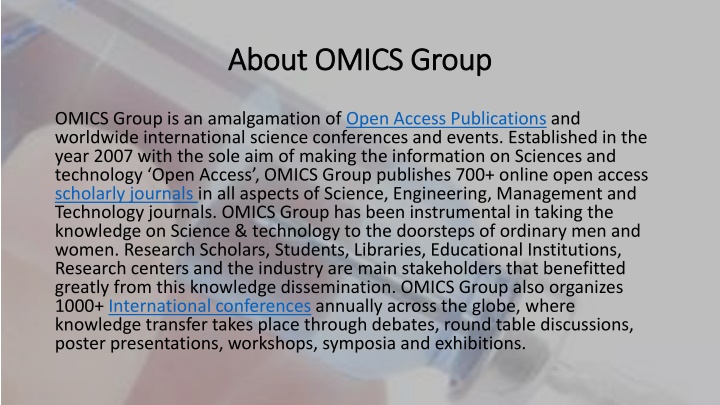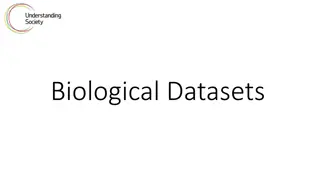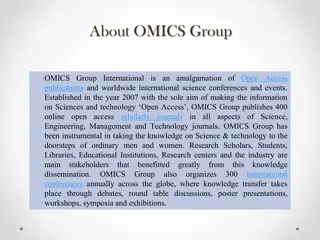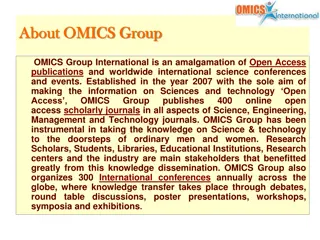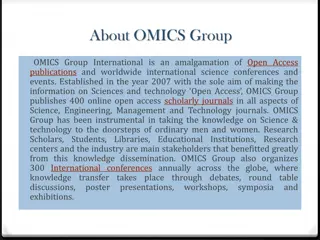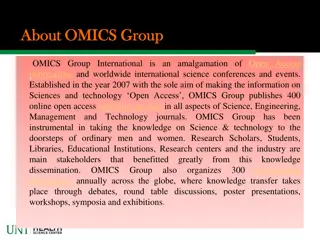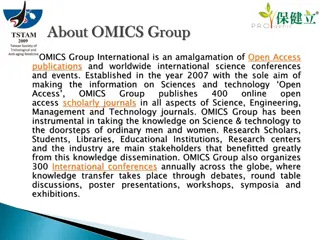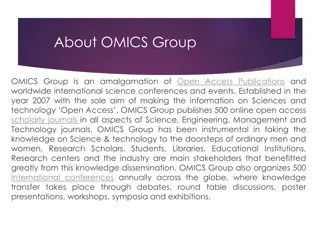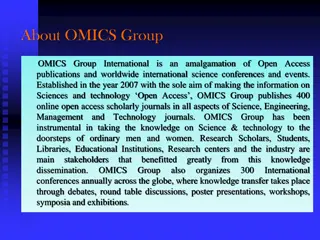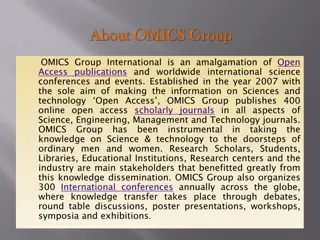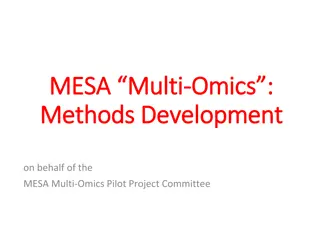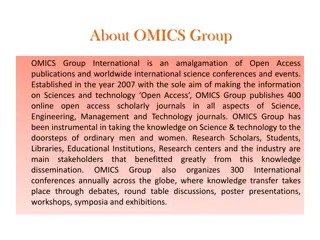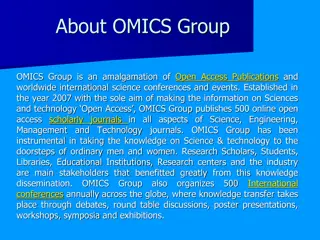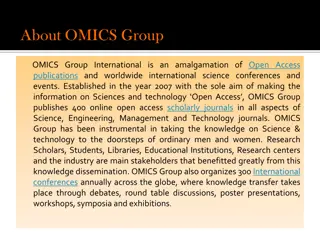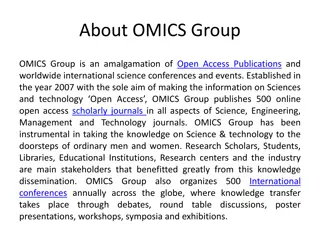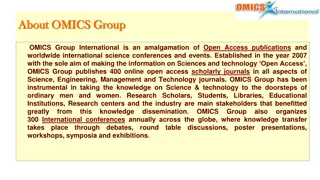About OMICS Group
Dargwa, a Nakh-Dagestanian language with around 500,000 speakers in Dagestan, Russia, exhibits unique characteristics such as ergative features, free word order, and rich morphology. This research delves into the genetic, areal, and typological aspects of Dargwa, specifically focusing on verbal root structures and aspects. The study explores the diagnostic suffixes, questions, and problems related to the database description of Dargwa. It also discusses the differentiation between simple and derived verbs, roots, inflectional affixes, and causative suffixes in the language. The in-depth analysis of approximately 200-250 verbal roots per language/dialect sheds light on the complexity and diversity of Dargwa's verbal root structure.
Download Presentation

Please find below an Image/Link to download the presentation.
The content on the website is provided AS IS for your information and personal use only. It may not be sold, licensed, or shared on other websites without obtaining consent from the author.If you encounter any issues during the download, it is possible that the publisher has removed the file from their server.
You are allowed to download the files provided on this website for personal or commercial use, subject to the condition that they are used lawfully. All files are the property of their respective owners.
The content on the website is provided AS IS for your information and personal use only. It may not be sold, licensed, or shared on other websites without obtaining consent from the author.
E N D
Presentation Transcript
About OMICS Group About OMICS Group OMICS Group is an amalgamation of Open Access Publications and worldwide international science conferences and events. Established in the year 2007 with the sole aim of making the information on Sciences and technology Open Access , OMICS Group publishes 700+ online open access scholarly journals in all aspects of Science, Engineering, Management and Technology journals. OMICS Group has been instrumental in taking the knowledge on Science & technology to the doorsteps of ordinary men and women. Research Scholars, Students, Libraries, Educational Institutions, Research centers and the industry are main stakeholders that benefitted greatly from this knowledge dissemination. OMICS Group also organizes 1000+ International conferences annually across the globe, where knowledge transfer takes place through debates, round table discussions, poster presentations, workshops, symposia and exhibitions.
OMICS International Conferences OMICS International Conferences OMICS International is a pioneer and leading science event organizer, which publishes around 700+ open access journals and conducts over 500 Medical, Clinical, Engineering, Life Sciences, Pharma scientific conferences all over the globe annually with the support of more than 1000 scientific associations and 30,000 editorial board members and 3.5 million followers to its credit. OMICS Group has organized 1000+ conferences, workshops and national symposiums across the major cities including San Francisco, Las Vegas, San Antonio, Omaha, Orlando, Raleigh, Santa Clara, Chicago, Philadelphia, Baltimore, United Kingdom, Valencia, Dubai, Beijing, Hyderabad, Bengaluru and Mumbai.
Purity, Endotoxin Level, and Trace Metal Comparison of Different Grades of Trehalose Ben Nelson, PhD. Formulation Solutions Manager ben.nelson@pfanstiehl.com http://www.pfanstiehl.com NON-CONFIDENTIAL PRESENTATION
Protein and Cell Stabilization Some Functions of Carbohydrates Reduction in denaturation caused by heat, stress, oxidation Prevention of mAb and protein aggregation Improvements in post-thaw cell viability Vaccine stabilization, membrane stabilization, phospholipid bilayer protection Depression of phase transition temperature of dry lipids, rendering them more resistant to damage during desiccation, maintains liquid crystalline phase in the absence of water (glassy state) Carbohydrates Used in Biotech Drug Products Trehalose Sucrose Mannitol Sorbitol
Marketed Drugs Formulated with Trehalose Drug Manufacturer API Class Formulation Type Adcetris Seattle Genetics ADC Lyophilized Powder Avastin Genentech/Roche mAb Solution Blincyto Amgen Bispecific mAb Lyophilized Powder Gazyva Genentech/Roche mAb Solution Herceptin Genentech/Roche mAb Lyophilized Powder Lucentis Genentech/Roche mAb Solution 5
Trehalose and Sucrose Comparison of Properties Ohtake and Wang, J. Pharm. Sci., 100(6), 2020, (2011)
Glass Transition Temperature (Tg) The temperature at which and amorphous material transitions between glass and rubber states. Below Tg = glass state lower mobility Above Tg = rubber state higher mobility The higher the Tg is above the storage temperature the less likely: Re-crystallization Chemical reactions: excipient/excipient and excipient/API (largely due to decreased mobility when in the glassy state) Water acts as a plasticizer the more water present, the lower Tg is.
Enthalpy of the Amorphous State Diagram depicting the energetics of a crystalline-liquid-amorphous system. As an amorphous material is held below its glass transition temperature, it relaxes to a lower energy state during a process referred to as aging or annealing.
Tg Prime (Tg) In the majority of cases solutes do not crystallize at the solubility limit as the sample is freezing. As the temperature is decreased, ice continues to form and the solution continues to concentrate until it is so viscous it turns to a glass. This glass transition temperature is denoted Tg The prime mark is used to denote this is the glass formed by freeze concentration
Tg/Tc vs Protein Concentration Tg measured by DSC Tc measured by freeze drying microscopy Every 1 C increase in product temperature results in ~13% reduction in primary drying time Sajal Patel Webinar
Equtorial OH Groups The more equatorial OH groups a disaccharides has the stronger interactions with water Helps Trehalose include itself in the water cluster with relative ease Sucrose does not integrate into the water cluster creating a larger structure of the sugar-water clusters. This prevents it from getting into smaller places.
Rate of Hydrolysis Free Energy of Glycosidic Bonds Trehalose <1 kcal/mol Sucrose = 27 kcal/mol Higher free energy bonds renders the disaccharide more susceptible to hydrolysis Non-acid catalyzed hydrolysis rates at 25 C: Trehalose = 3.3 10-15 s-1 Sucrose = 5 10-11 s-1 Stability after 1 hour in solution at pH = 3.5: Trehalose remaining >99% Sucrose remaining ~0%
Hydration Number Disaccharides at high concentration have a scarcity of water in their vicinity, thus intramolecular hydrogen bond formation is needed. The arrangement of intramolecular hydrogen bonds results in a folded configuration (around the glycosidic bond) and thus a reduction in hydration number Does this make the glycosidic bond more susceptible to glycolysis, resulting in more reducing sugars? Trehalose exhibits no such configurational changes
Total Impurities and Endotoxin Levels Total Impurities (%) Endotoxins (EU/g) Grade (# of Lots Tested) Data Range Data Mean Data Range Data Mean Food (6) 0.69 1.00 0.21 2.30 0.84 0.12 1.17 0.77 Technical (6) 0.42 0.68 0.54 4.10 0.54 0.11 0.84 0.12 <LOQ 0.33 0.06 0.09* Pfanstiehl High Purity (16) 0.06 0.17 0.14 0.03 *Only two lots tested above the LOQ (0.05 EU/g). For lots tested <LOQ a value of 0.025 was used in the calculation of the mean.
Trace Metal Profile of Pfanstiehl Trehalose Elements V Cr Mn Fe Ni Cu Zn As Mo Ru Rh Pd Cd Os Ir Pt Hg Pb Limit (ppm) Limit of Quantitation (ppm) Lot 1 1 2.5 25 130 2.5 10 130 0.15 1.0 1.0 1.0 1.0 0.25 1.0 1.0 1.0 0.15 0.5 0.5 0.5 5 26 1 5 26 0.03 0.5 0.2 0.2 0.2 0.05 0.2 0.2 0.2 0.03 0.1 <0.5 <0.5 <5 <26 <1 <5 <26 <0.03 <0.5 <0.2 <0.2 <0.2 0.11 <0.2 <0.2 <0.2 <0.03 <0.1 Lot 2 <0.5 <0.5 <5 <26 <1 <5 <26 <0.03 <0.5 <0.2 <0.2 <0.2 <0.05 <0.2 <0.2 <0.2 <0.03 <0.1 Lot 3 <0.5 <0.5 <5 <26 <1 <5 <26 <0.03 <0.5 <0.2 <0.2 <0.2 <0.05 <0.2 <0.2 <0.2 <0.03 <0.1 Lot 4 <0.5 <0.5 <5 <26 <1 <5 <26 <0.03 <0.5 <0.2 <0.2 <0.2 <0.05 <0.2 <0.2 <0.2 <0.03 <0.1 Lot 5 <0.5 <0.5 <5 <26 <1 <5 <26 <0.03 <0.5 <0.2 <0.2 <0.2 <0.05 <0.2 <0.2 <0.2 <0.03 <0.1 Lot 6 <0.5 <0.5 <5 <26 <1 <5 <26 <0.03 <0.5 <0.2 <0.2 <0.2 <0.05 <0.2 <0.2 <0.2 <0.03 <0.1 Lot 7 <0.5 <0.5 <5 <26 <1 <5 <26 <0.03 <0.5 <0.2 <0.2 <0.2 <0.05 <0.2 <0.2 <0.2 <0.03 <0.1 Lot 8 <0.5 <0.5 <5 <26 <1 <5 <26 <0.03 <0.5 <0.2 <0.2 <0.2 <0.05 <0.2 <0.2 <0.2 <0.03 <0.1 Lot 9 <0.5 <0.5 <5 <26 <1 <5 <26 <0.03 <0.5 <0.2 <0.2 <0.2 <0.05 <0.2 <0.2 <0.2 <0.03 <0.1 Lot 10 <0.5 <0.5 <5 <26 <1 <5 <26 <0.03 <0.5 <0.2 <0.2 <0.2 <0.05 <0.2 <0.2 <0.2 <0.03 <0.1
Pfanstiehl Know Your Product & Process Initiative Additional Characterization Functional Testing Particle Size Polymorph DSC Residual Elemental Impurities Nanoparticulates Conductivity Dexrtrins Glucans Impurity Profile 2D NMR Dissolution Studies Customer Function (Formulation Stability Testing etc.) 19
1H T1 vs Impurity Content 50 45 40 R = 0.9967 35 1H T1 (s-2) 30 25 20 15 Log Fit 10 5 0 Impurity Content (1/%)
1H T1 vs Impurity Content 35 30 25 R = 0.9823 20 1H T1 (s-2) 15 Log Fit 10 5 0 Impurity Content (1/%) 21
Contact Information Ben Nelson Pfanstiehl 1219 Glen Rock Avenue Waukegan, IL 60085 Office: 847-599-5139 Email: ben.nelson@pfanstiehl.com 23
Let us meet again.. Let us meet again.. We welcome you all to our future conferences of OMICS International 2nd International Conference and Expo on Parenterals and Injectables On October 24-26, 2016 at Istanbul, Turkey http://parenterals-injectables.pharmaceuticalconferences.com/
